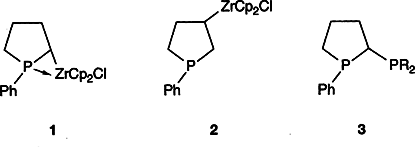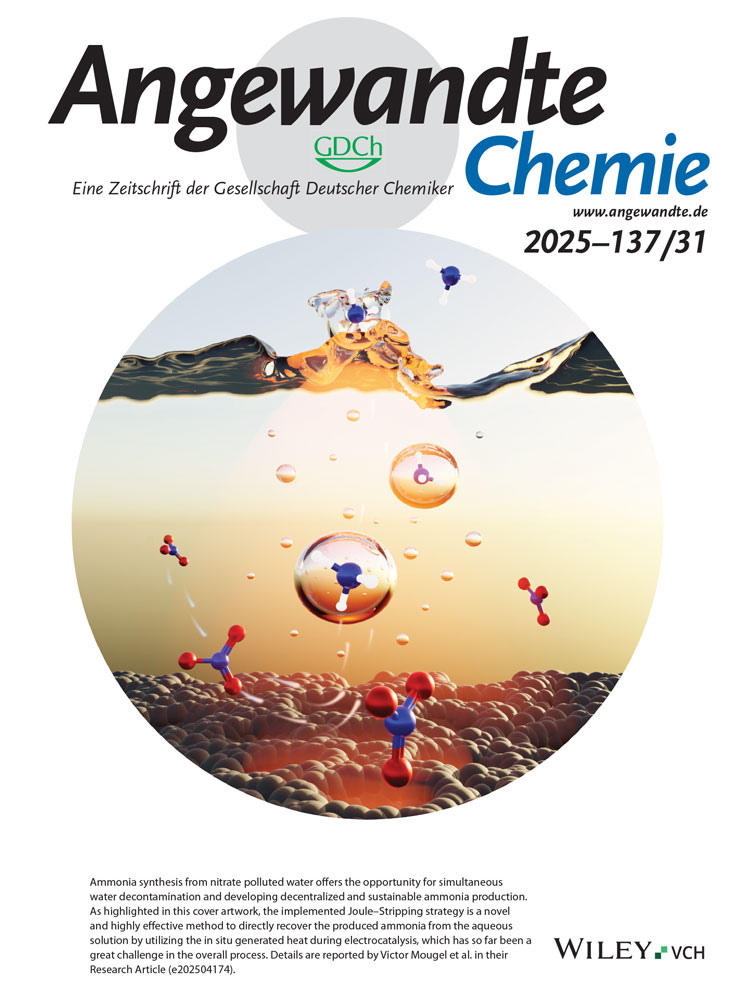Inverse Hydrozirconierung–ein regio- und diastereospezifischer Weg zu neuen Diphosphanen†
Dr. Maria Zablocka
Centre of Molecular and Macromolecular Studies Polish Academy of Sciences Sienkiewicza 112, PL-90-362 Lodz (Polen)
Search for more papers by this authorFlorence Boutonnet
Laboratoire de Chimie de Coordination du CNRS 205, route de Narbonne, F-31077 Toulouse Cédex (Frankreich)
Search for more papers by this authorDr. Alain Igau
Laboratoire de Chimie de Coordination du CNRS 205, route de Narbonne, F-31077 Toulouse Cédex (Frankreich)
Search for more papers by this authorDr. Francoise Dahan
Laboratoire de Chimie de Coordination du CNRS 205, route de Narbonne, F-31077 Toulouse Cédex (Frankreich)
Search for more papers by this authorCorresponding Author
Dr. Jean Pierre Majoral
Laboratoire de Chimie de Coordination du CNRS 205, route de Narbonne, F-31077 Toulouse Cédex (Frankreich)
Jean Pierre Majoral, Laboratoire de Chimie de Coordination du CNRS 205, route de Narbonne, F-31077 Toulouse Cédex (Frankreich)
K. Michal Pietrusiewicz, Centre of Molecular and Macromolecular Studies Polish Academy of Sciences Sienkiewicza 112, PL-90-362 Lodz (Polen)
Search for more papers by this authorCorresponding Author
Dr. K. Michal Pietrusiewicz
Centre of Molecular and Macromolecular Studies Polish Academy of Sciences Sienkiewicza 112, PL-90-362 Lodz (Polen)
Jean Pierre Majoral, Laboratoire de Chimie de Coordination du CNRS 205, route de Narbonne, F-31077 Toulouse Cédex (Frankreich)
K. Michal Pietrusiewicz, Centre of Molecular and Macromolecular Studies Polish Academy of Sciences Sienkiewicza 112, PL-90-362 Lodz (Polen)
Search for more papers by this authorDr. Maria Zablocka
Centre of Molecular and Macromolecular Studies Polish Academy of Sciences Sienkiewicza 112, PL-90-362 Lodz (Polen)
Search for more papers by this authorFlorence Boutonnet
Laboratoire de Chimie de Coordination du CNRS 205, route de Narbonne, F-31077 Toulouse Cédex (Frankreich)
Search for more papers by this authorDr. Alain Igau
Laboratoire de Chimie de Coordination du CNRS 205, route de Narbonne, F-31077 Toulouse Cédex (Frankreich)
Search for more papers by this authorDr. Francoise Dahan
Laboratoire de Chimie de Coordination du CNRS 205, route de Narbonne, F-31077 Toulouse Cédex (Frankreich)
Search for more papers by this authorCorresponding Author
Dr. Jean Pierre Majoral
Laboratoire de Chimie de Coordination du CNRS 205, route de Narbonne, F-31077 Toulouse Cédex (Frankreich)
Jean Pierre Majoral, Laboratoire de Chimie de Coordination du CNRS 205, route de Narbonne, F-31077 Toulouse Cédex (Frankreich)
K. Michal Pietrusiewicz, Centre of Molecular and Macromolecular Studies Polish Academy of Sciences Sienkiewicza 112, PL-90-362 Lodz (Polen)
Search for more papers by this authorCorresponding Author
Dr. K. Michal Pietrusiewicz
Centre of Molecular and Macromolecular Studies Polish Academy of Sciences Sienkiewicza 112, PL-90-362 Lodz (Polen)
Jean Pierre Majoral, Laboratoire de Chimie de Coordination du CNRS 205, route de Narbonne, F-31077 Toulouse Cédex (Frankreich)
K. Michal Pietrusiewicz, Centre of Molecular and Macromolecular Studies Polish Academy of Sciences Sienkiewicza 112, PL-90-362 Lodz (Polen)
Search for more papers by this authorDiese Arbeit wurde vom CNRS (Frankreich) und dem Committee for Scientific Research (Polen), Förder-Nr. 2 1307 91 01. gefördert.
Abstract
Die zusätzliche Stabilisierung durch die dative P-Zr-Bindung bewirkt, daß bei der Hydrozirconierung von 1-Phenyl-2,3-dihydrophosphol regio-und diastereo-spezifisch die α-1 als auch dem üblichen ß-substituierten Produkt 2 der Hydrozirconierung mit denselben Chlorphosphanen selektiv die Diphosphane 3 erhalten werden.
References
- 1(a)
Übersichten:
E. Negishi,
T. Takahashi,
Synthesis
1988
1;
(b)
J. A. Labinger
in Comprehensive Organic Synthesis,
Vol. 8
(Hrsg.: B. M. Trost,
I. Fleming),
Pergamon,
1991,
S. 667.
10.1016/B978-0-08-052349-1.00242-0 Google Scholar
- 2 I. Hyla-Kryspin, R. Gleiter, C. Krüger, R. Zwettler, G. Erker, Organometallics 1990, 9, 517; G. Erker, R. Zwettler, C. Krüger, I. Hyla-Kryspin, R. Gleiter, Organometallics 1990, 9, 524, zit. Lit.
- 3 H. H. Karsch, B. Denbelly, J. Hofmann, U. Pieper, G. Müller, J. Am. Chem. Soc. 1988, 110, 3654; J.-P. Majoral, N. Dufour, F. Meyer, A.-M. Caminade, R. Choukroun, D. Gervais, J. Chem. Soc. Chem. Commun. 1990, 507; N. Dufour, J.-P. Majoral, A.-M. Caminade, R. Choukroun, Organometallics 1991, 10, 45; N. Dufour, A.-M. Caminade, M. Basso-Bert, A. Igau, J.-P. Majoral, Organometallics 1992, 11, 131; A. Igau, N. Dufour, A. Maheu, J.-P. Majoral, Angew. Chem. 1993, 105, 76; Angew. Chem. Int. Ed. Engl. 1993, 32, 95.
- 4 G. A. Gray, S. E. Cremer, K. I. Marsi, J. Am. Chem. Soc. 1976, 98, 2109.
- 5 Die Hydrozirconierung von 2-Vinylfuran sollte das terminal substituierte Produkt liefern, das jedoch nicht gebildet wurde. Als Gründe für die Bildung des am sekundären C-Atom substituierten Produkts wurden O-Koordination, aromatische Stabilisierung oder geringere sterische Effekte des planaren Furanrings oder eine Kombination derselben vorgeschlagen [9].
- 6 Kristalldaten von 12: C22H22P2, P21- c, monoklin, a = 10.072(1), b = 11.655(1), c = 16.697(2) Å β = 102.99(2)°, Z = 4, V = 1909.9(7) Å3, M = 348.4, ϱber. = 1.211 gcm−3,μ= 2.2cm−1; 2644 unabhängige Reflexe wurden gemessen, von denen 1736 mit I > 3δ (I) zur Verfeinerung zu R = 0.048, Rw = 0.023 verwendet wurden. Weitere Einzelheiten zur Kristallstrukturuntersuchung können beim Fachinformationszentrum Karlsruhe, Gesellschaft für wissenschaftlich-technische Information mbH, D-76344 Eggenstein-Leopoldshafen, unter Angabe der Hinterlegungs-nummer CSD-57481, der Autoren und des Zeitschriftenzitats angefordert werden.
- 7 M. Koprowski, K. M. Pietrusiewicz, unveröffentlicht.
- 8 Phospholan-Liganden: M. J. Burk, J. Am. Chem. Soc. 1991, 113, 8518; M. J. Burk, J. E. Feaster, J. Am. Chem. Soc. 1992, 114, 6266; J. C. Fiaud, J. Y. Legros, Tetrahedron Lett, 1991, 38, 5089.
- 9 S. L. Buchwald, S. J. LaMaire, Tetrahedron Lett. 1987, 28, 295.
- 10 Die eingesetzten 1-Phenyldihydrophosphole 2 (γ31P = −2.0) und 4 (γ31P = −25.6) wurden aus den korrespondierenden Oxiden [11] durch Reduktion mit PhSiH3 in C6H6 bei 60°C hergestellt.
- 11 L. D. Quin, The Heterocyclic Chemistry of Phosphorus, Wiley-Interscience, New York, 1981.
Citing Literature
This is the
German version
of Angewandte Chemie.
Note for articles published since 1962:
Do not cite this version alone.
Take me to the International Edition version with citable page numbers, DOI, and citation export.
We apologize for the inconvenience.





